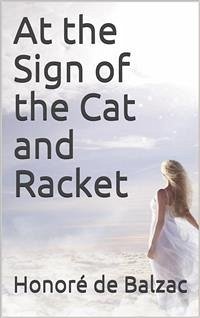La Maison du chat-qui-pelote (At the Sign of the Cat and Racket) is a novel by Honoré de Balzac. It is the opening work in the Scènes de la vie privée (Scenes of Private Life), which comprises the first volume of Balzac's La Comédie humaine.
The idea for the story came from the haberdashery business run by the Sallambiers on the maternal side of Balzac's family.
The artist Théodore de Sommervieux falls in love with Augustine Guillaume, the daughter of a conservative cloth merchant, whose house of business on the Rue Saint-Denis in Paris is known by sign of the Cat and Racket. Théodore, a winner of the Prix de Rome and a knight of the Legion of Honor, is famous for his interiors and chiaroscuro effects in imitation of the Dutch School. He makes an excellent reproduction of the interior of the Cat and Racket, which is exhibited at the Salon alongside a strikingly modern portrait of Augustine. The affair blossoms with the help of Madame Guillaume's younger cousin Madame Roguin, who is already acquainted with Théodore. The lovers become engaged, somewhat against the best wishes of Augustine's parents, who had originally intended her to marry Monsieur Guillaume's clerk Joseph Lebas. In 1808 Augustine marries Théodore at the local church of Saint-Leu; on the same day her elder sister Virginie marries Lebas.
The marriage is not a happy one. Augustine adores Sommervieux but is incapable of understanding him as an artist. Although she is more refined than her parents, her education and social standing leave her too far below the level of her husband to allow a meeting of minds to take place. Théodore's passion for her cools and she is treated with disdain by his fellow artists. Théodore instead finds a kindred soul in the Duchesse de Carigliano, to whom he gives the famous portrait of Augustine and to whom he becomes hopelessly attached, neglecting his rooms on the Rue des Trois-Frères (now a part of the Rue Taitbout).
Realizing after three years of unhappiness that her marriage is falling apart and having been informed by a malicious gossip of Théodore's attachment to the duchess, Augustine visits Madame de Carigliano not to ask her to give her back her husband's heart but to learn the arts by which it has been captured. The duchess warns her against trying to conquer a man's heart through love, which will only allow the husband to tyrannize over the wife; instead a woman must use all the arts of coquetry that nature puts at her disposal. Augustine is shocked to learn that Madame de Carigliano sees marriage as a form of warfare. The duchess then returns to Augustine her own portrait, telling her that if she cannot conquer her husband with this weapon, she is not a woman.
Read this complete famous novel for further interesting story....
The idea for the story came from the haberdashery business run by the Sallambiers on the maternal side of Balzac's family.
The artist Théodore de Sommervieux falls in love with Augustine Guillaume, the daughter of a conservative cloth merchant, whose house of business on the Rue Saint-Denis in Paris is known by sign of the Cat and Racket. Théodore, a winner of the Prix de Rome and a knight of the Legion of Honor, is famous for his interiors and chiaroscuro effects in imitation of the Dutch School. He makes an excellent reproduction of the interior of the Cat and Racket, which is exhibited at the Salon alongside a strikingly modern portrait of Augustine. The affair blossoms with the help of Madame Guillaume's younger cousin Madame Roguin, who is already acquainted with Théodore. The lovers become engaged, somewhat against the best wishes of Augustine's parents, who had originally intended her to marry Monsieur Guillaume's clerk Joseph Lebas. In 1808 Augustine marries Théodore at the local church of Saint-Leu; on the same day her elder sister Virginie marries Lebas.
The marriage is not a happy one. Augustine adores Sommervieux but is incapable of understanding him as an artist. Although she is more refined than her parents, her education and social standing leave her too far below the level of her husband to allow a meeting of minds to take place. Théodore's passion for her cools and she is treated with disdain by his fellow artists. Théodore instead finds a kindred soul in the Duchesse de Carigliano, to whom he gives the famous portrait of Augustine and to whom he becomes hopelessly attached, neglecting his rooms on the Rue des Trois-Frères (now a part of the Rue Taitbout).
Realizing after three years of unhappiness that her marriage is falling apart and having been informed by a malicious gossip of Théodore's attachment to the duchess, Augustine visits Madame de Carigliano not to ask her to give her back her husband's heart but to learn the arts by which it has been captured. The duchess warns her against trying to conquer a man's heart through love, which will only allow the husband to tyrannize over the wife; instead a woman must use all the arts of coquetry that nature puts at her disposal. Augustine is shocked to learn that Madame de Carigliano sees marriage as a form of warfare. The duchess then returns to Augustine her own portrait, telling her that if she cannot conquer her husband with this weapon, she is not a woman.
Read this complete famous novel for further interesting story....









